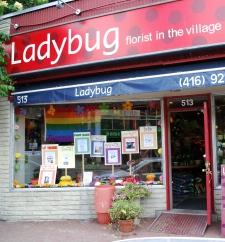It was a small reminder of how far Canada has come in addressing and lesbian rights — and how far we have yet to go.
Paul Winsor, manager of the Ladybug Florist in the Church-Wellesley Village, decided to go the extra mile when decorating the front window of the store for Pride Week, turning it into historical timeline of Canada’s gay history.
Winsor, who has worked at Ladybug since the store opened nearly 12 years ago, said he was inspired to create the display featuring a row of protest placards among a bed of flowers in response to Pride Toronto’s theme, “Can’t Stop, Won’t Stop.”
“The theme really leant itself to the nature of the display I did: protest,” he said. “People have protested throughout the years for the rights and freedom that they’ve earned.”
Among the events depicted on the placards was the passing of Bill C-150 in 1969 by then Prime Minister Pierre Trudeau. It decriminalized gay sex. Also commemorated in Winsor’s display was the Toronto bathhouse raids of 1981 and the legalization of same-sex marriage in 2005.
Looking back to his childhood, Winsor says the project gave him a chance to reflect on how queer rights issues paralleled his own journey.
He was seven years old and living in a conservative community in Newfoundland when Trudeau famously declared, “There is no place for the state in the bedrooms of the nation.”
Winsor recalled the controversy that swirled around the remarks and “not quite being old enough to understand the fundamentals, but knowing that this was something monumental that was no doubt going to have an impact on my life.”
Winsor moved to Toronto with his partner in 1997. Thanks to changes to Canada’s spousal benefit laws in 2000, he was able to receive benefits from his partner’s employer, a Catholic organization.
He found most of the information in online archives and other sources.
Winsor said he hopes the information will help educate younger queer people about the rights they enjoy, while drawing attention to inequalities that exist elsewhere in the world.
“For them, it’s the norm, but I just think it’s a good idea to make people stop and think,” he said.

 Why you can trust Xtra
Why you can trust Xtra


